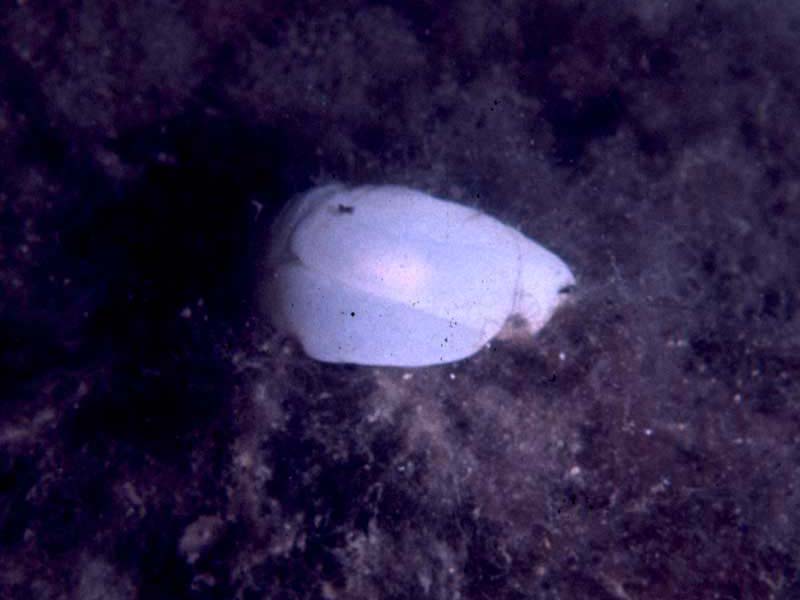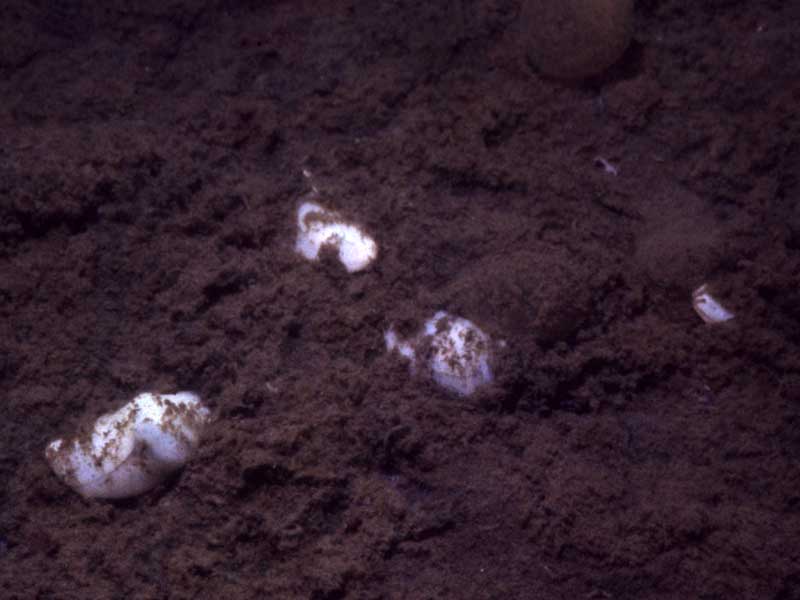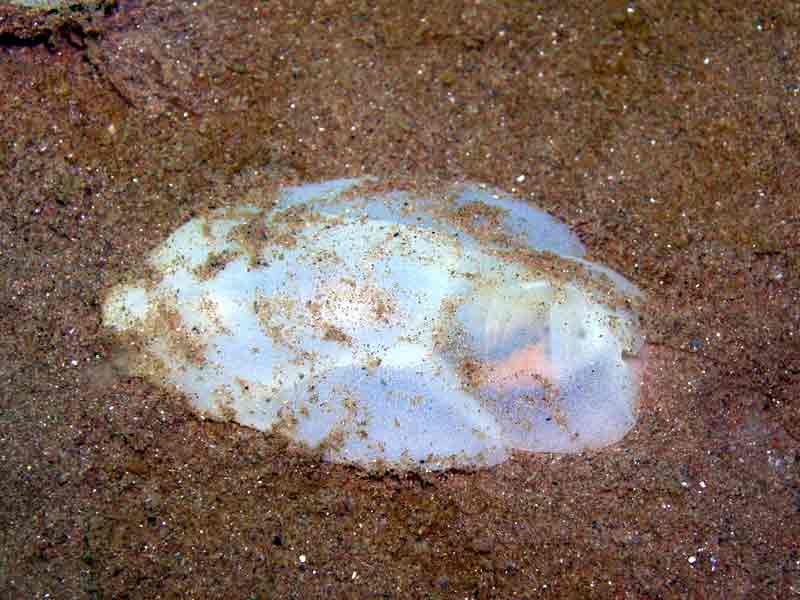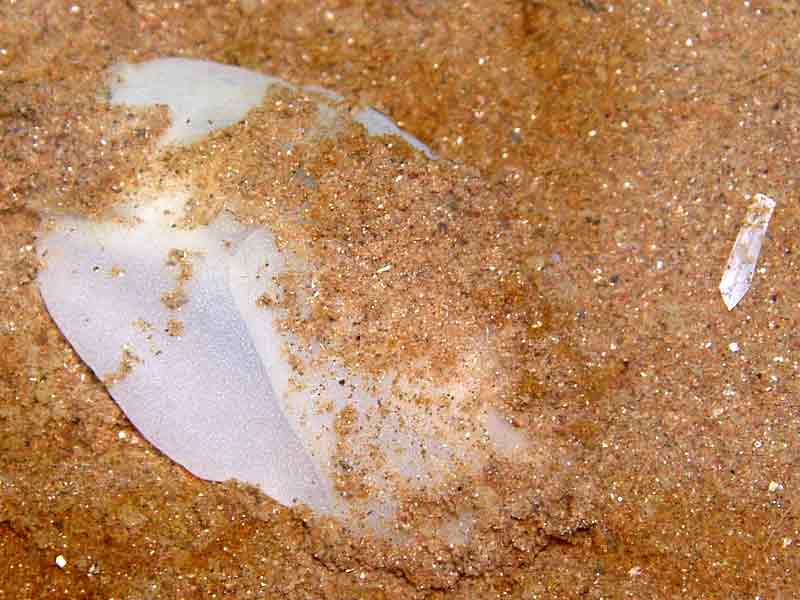Lobe shell (Philine quadripartita)
Distribution data supplied by the Ocean Biodiversity Information System (OBIS). To interrogate UK data visit the NBN Atlas.Map Help
| Researched by | Emily Wilson | Refereed by | This information is not refereed |
| Authority | Ascanius, 1772 | ||
| Other common names | - | Synonyms | - |
Summary
Description
Philine quadripartita is 1 to 3 cm in length and white in colour. The soft body is divided into four lobes: a frontal 'cephalic' shield, a posterior shield, and two parapodial lobes either side of the body. The body is white. The cephalic shield is longer than the posterior shield. The posterior sheild has a small internal shell that can be felt at the hind end of the animal. This species characteristically secretes sulphuric acid as a defence against predators.
Recorded distribution in Britain and Ireland
Recorded all around the British Isles.Global distribution
Recorded from the North East Atlantic and the Mediterranean.Habitat
A sublittoral sea slug spending most of its life beneath the surface of the sand/muddy sand in which it seeks its prey.Depth range
0-500mIdentifying features
- Quadripartite; right and left parapodial lobes, cephalic shield (head), and posterior mantle lobe over the visceral mass.
- White in colour with white dots; up to 3 cm in length.
Additional information
Records of Philine quadripartita in the British Isles were misidentified as Philine aperta (Price et al., 2011). Outwardly, most species of Philine are very similar in morphology and a detailed examination of their internal anatomy, especially the shape of the internal shell, gizzard and penial papilla, is required to differentiate the species (Price et al., 2011). Philine aperta is recorded from South Africa and Mozambique.
Listed by
- none -
Biology review
Taxonomy
| Level | Scientific name | Common name |
|---|---|---|
| Phylum | Mollusca | Snails, slugs, mussels, cockles, clams & squid |
| Class | Gastropoda | Snails, slugs & sea butterflies |
| Order | Cephalaspidea | Bubble snails |
| Family | Philinidae | |
| Genus | Philine | |
| Authority | Ascanius, 1772 | |
| Recent Synonyms | ||
Biology
| Parameter | Data | ||
|---|---|---|---|
| Typical abundance | Moderate density | ||
| Male size range | 3 cm | ||
| Male size at maturity | |||
| Female size range | Small (1-2 cm) | ||
| Female size at maturity | |||
| Growth form | Globose | ||
| Growth rate | Data deficient | ||
| Body flexibility | Low (10-45 degrees) | ||
| Mobility | Burrower | ||
| Characteristic feeding method | Predator | ||
| Diet/food source | Carnivore | ||
| Typically feeds on | Pectinaria koreni, Echinocyamus pusillus, foraminiferans, and small infaunal lamellibranchs and gastropods. | ||
| Sociability | Solitary | ||
| Environmental position | Infaunal | ||
| Dependency | Independent. | ||
| Supports | No information | ||
| Is the species harmful? | Yes Sulphuric acid secretion from the skin give it some protection from predators, which include fish. | ||
Biology information
- Philine quadripartita lives just beneath the surface of fine sediment. The species 'ploughs' through the sediment as it moves and should not really be considered as burrowing species.
- Although the species has an internal shell, this is small relative to the total body size and there is therefore, some flexibility.
- A scavenging habit was observed under laboratory conditions on freshly killed bivalves.
Habitat preferences
| Parameter | Data |
|---|---|
| Physiographic preferences | Data deficient |
| Biological zone preferences | Lower eulittoral, Sublittoral fringe, Upper infralittoral |
| Substratum / habitat preferences | Fine clean sand, Muddy sand, Sandy mud |
| Tidal strength preferences | |
| Wave exposure preferences | |
| Salinity preferences | Data deficient |
| Depth range | 0-500m |
| Other preferences | No text entered |
| Migration Pattern | No information found |
Habitat Information
No text enteredLife history
Adult characteristics
| Parameter | Data |
|---|---|
| Reproductive type | Permanent (synchronous) hermaphrodite |
| Reproductive frequency | Annual episodic |
| Fecundity (number of eggs) | 10,000-100,000 |
| Generation time | Insufficient information |
| Age at maturity | Insufficient information |
| Season | April - August |
| Life span | 2-5 years |
Larval characteristics
| Parameter | Data |
|---|---|
| Larval/propagule type | - |
| Larval/juvenile development | Planktotrophic |
| Duration of larval stage | 1-6 months |
| Larval dispersal potential | Greater than 10 km |
| Larval settlement period | Insufficient information |
Life history information
Longevity is believed to be 3-4 years. In Britain spawning has been recorded from spring to summer when flask-shaped egg masses are laid. Egg masses may each contain up to 50,000 white ova. Veliger larvae hatch after a few days.Sensitivity review
The MarLIN sensitivity assessment approach used below has been superseded by the MarESA (Marine Evidence-based Sensitivity Assessment) approach (see menu). The MarLIN approach was used for assessments from 1999-2010. The MarESA approach reflects the recent conservation imperatives and terminology and is used for sensitivity assessments from 2014 onwards.
Physical pressures
Use / to open/close text displayed
| Intolerance | Recoverability | Sensitivity | Evidence / Confidence | |
Substratum loss [Show more]Substratum lossBenchmark. All of the substratum occupied by the species or biotope under consideration is removed. A single event is assumed for sensitivity assessment. Once the activity or event has stopped (or between regular events) suitable substratum remains or is deposited. Species or community recovery assumes that the substratum within the habitat preferences of the original species or community is present. Further details EvidencePhiline quadripartita is an infaunal species and so loss of substratum would result in loss of the population. Intolerance is therefore, assessed as High. Recovery would be high due to the fast growth, fast reproductive rates of the species and recolonization from other areas as the species is common where it occurs. | High | High | Moderate | Moderate |
Smothering [Show more]SmotheringBenchmark. All of the population of a species or an area of a biotope is smothered by sediment to a depth of 5 cm above the substratum for one month. Impermeable materials, such as concrete, oil, or tar, are likely to have a greater effect. Further details. EvidencePhiline quadripartita lives just beneath the surface of the sediment and is capable of moving through it. Therefore, smothering by a layer of 5 cm would have little or no effect on the species and a rank of not sensitive is recorded. Impermeable materials, such as concrete, oil or tar, are likely to have a greater effect. | Tolerant | Not relevant | Not sensitive | Moderate |
Increase in suspended sediment [Show more]Increase in suspended sedimentBenchmark. An arbitrary short-term, acute change in background suspended sediment concentration e.g., a change of 100 mg/l for one month. The resultant light attenuation effects are addressed under turbidity, and the effects of rapid settling out of suspended sediment are addressed under smothering. Further details EvidencePhiline quadripartita is a carnivore and lives buried under the sediment surface, therefore an increase in suspended sediments is unlikely to have an effect on the population or the burrowing organisms that they feed on. | Tolerant | Not relevant | Not sensitive | Moderate |
Decrease in suspended sediment [Show more]Decrease in suspended sedimentBenchmark. An arbitrary short-term, acute change in background suspended sediment concentration e.g., a change of 100 mg/l for one month. The resultant light attenuation effects are addressed under turbidity, and the effects of rapid settling out of suspended sediment are addressed under smothering. Further details Evidence | No information | |||
Desiccation [Show more]Desiccation
EvidenceThe subtidal position and soft-bodied nature of this species suggests that it is unlikely to tolerate desiccation. However, the species is sufficiently mobile and capable of burrowing therefore, it is likely to be able to move to an area which is more favourable. Recovery would be high, provided conditions were suitable, due to the fast growth, fast reproductive rates of the species and recolonization from other areas as the species is common where it occurs. | Not relevant | Not relevant | Not relevant | Moderate |
Increase in emergence regime [Show more]Increase in emergence regimeBenchmark. A one hour change in the time covered or not covered by the sea for a period of one year. Further details EvidenceThe subtidal position and soft-bodied nature of this species suggests that it is unlikely to tolerate emersion as it would suffer desiccation. However, the species is sufficiently mobile and capable of burrowing therefore, it is likely to be able to move to an area which is more favourable. Recovery would be high due, provided conditions were suitable, to the fast growth, fast reproductive rates of the species and recolonization from other areas as the species is common where it occurs. | Not relevant | Not relevant | Not relevant | Moderate |
Decrease in emergence regime [Show more]Decrease in emergence regimeBenchmark. A one hour change in the time covered or not covered by the sea for a period of one year. Further details Evidence | No information | |||
Increase in water flow rate [Show more]Increase in water flow rateA change of two categories in water flow rate (view glossary) for 1 year, for example, from moderately strong (1-3 knots) to very weak (negligible). Further details EvidenceThe species is found predominantly on finer sediments which are associated with sheltered locations. Increased water flow rate is likely to change the nature of sediment and hence the character of the habitat as fine particles are washed away. Increased water flow rate could also sweep adults away and so intolerance is recorded as high. | High | High | Moderate | Moderate |
Decrease in water flow rate [Show more]Decrease in water flow rateA change of two categories in water flow rate (view glossary) for 1 year, for example, from moderately strong (1-3 knots) to very weak (negligible). Further details Evidence | No information | |||
Increase in temperature [Show more]Increase in temperature
For intertidal species or communities, the range of temperatures includes the air temperature regime for that species or community. Further details EvidenceSpawning, hatching and time to metamorphosis are all temperature dependent. Spawning occurs during the warmest months of the year (April to August) (Lancaster, 1983). Laboratory results showed hatching occurred after 3.5 days at 23°C and 8 days at 13°C (Thompson, 1976) and time to metamorphosis occurred after 35-40 days at 12-13°C and 30 days at 15°C (Hansen & Ockelmann, 1991). A change in temperature at the benchmark level would be unlikely to have lethal effects however, and an intolerance of low is recorded. Colder temperatures would delay development and recruitment to a population. | Low | High | Low | Low |
Decrease in temperature [Show more]Decrease in temperature
For intertidal species or communities, the range of temperatures includes the air temperature regime for that species or community. Further details Evidence | No information | |||
Increase in turbidity [Show more]Increase in turbidity
EvidenceNeither the species or the burrowing organisms on which it lives are dependant on light availability, so it would not be affected by a change in turbidity. | Tolerant | Not relevant | Not sensitive | Moderate |
Decrease in turbidity [Show more]Decrease in turbidity
Evidence | No information | |||
Increase in wave exposure [Show more]Increase in wave exposureA change of two ranks on the wave exposure scale (view glossary) e.g., from Exposed to Extremely exposed for a period of one year. Further details EvidenceThe species is found predominantly on finer sediments which are associated with wave sheltered locations. Increased wave exposure is likely to erode fine sediments and displace adult Philine quadripartita. Intolerance to wave exposure is therefore assessed as High. | High | High | Moderate | Moderate |
Decrease in wave exposure [Show more]Decrease in wave exposureA change of two ranks on the wave exposure scale (view glossary) e.g., from Exposed to Extremely exposed for a period of one year. Further details Evidence | No information | |||
Noise [Show more]Noise
EvidenceThe species probably has very limited capacity for noise perception. | Tolerant | Not relevant | Not sensitive | Low |
Visual presence [Show more]Visual presenceBenchmark. The continuous presence for one month of moving objects not naturally found in the marine environment (e.g., boats, machinery, and humans) within the visual envelope of the species or community under consideration. Further details EvidenceThe species probably has very limited capacity for visual perception. | Tolerant | Not relevant | Not sensitive | Low |
Abrasion & physical disturbance [Show more]Abrasion & physical disturbanceBenchmark. Force equivalent to a standard scallop dredge landing on or being dragged across the organism. A single event is assumed for assessment. This factor includes mechanical interference, crushing, physical blows against, or rubbing and erosion of the organism or habitat of interest. Where trampling is relevant, the evidence and trampling intensity will be reported in the rationale. Further details. EvidenceThe species is soft bodied and has a delicate internal shell and therefore likely to be damaged on impact by a passing scallop dredge. Therefore, a proportion of the population is likely to be lost and an intolerance of intermediate has been recorded. Recovery would be high due to the fast growth, fast reproductive rates of the species and recolonization from other areas, as the species is common. | Intermediate | High | Low | Moderate |
Displacement [Show more]DisplacementBenchmark. Removal of the organism from the substratum and displacement from its original position onto a suitable substratum. A single event is assumed for assessment. Further details EvidencePhiline quadripartita is sufficiently mobile to be able to deal with displacement provided a suitable substratum is found. | Tolerant | Not relevant | Not sensitive | Moderate |
Chemical pressures
Use [show more] / [show less] to open/close text displayed
| Intolerance | Recoverability | Sensitivity | Evidence / Confidence | |
Synthetic compound contamination [Show more]Synthetic compound contaminationSensitivity is assessed against the available evidence for the effects of contaminants on the species (or closely related species at low confidence) or community of interest. For example:
The evidence used is stated in the rationale. Where the assessment can be based on a known activity then this is stated. The tolerance to contaminants of species of interest will be included in the rationale when available; together with relevant supporting material. Further details. EvidenceInsufficientinformation | No information | No information | No information | Not relevant |
Heavy metal contamination [Show more]Heavy metal contaminationEvidenceInsufficientinformation | No information | No information | No information | Not relevant |
Hydrocarbon contamination [Show more]Hydrocarbon contaminationEvidenceInsufficientinformation | No information | No information | No information | Not relevant |
Radionuclide contamination [Show more]Radionuclide contaminationEvidenceInsufficientinformation | No information | No information | No information | Not relevant |
Changes in nutrient levels [Show more]Changes in nutrient levelsEvidenceInsufficientinformation | No information | No information | No information | Not relevant |
Increase in salinity [Show more]Increase in salinity
EvidenceInsufficientinformation | No information | No information | No information | Not relevant |
Decrease in salinity [Show more]Decrease in salinity
Evidence | No information | |||
Changes in oxygenation [Show more]Changes in oxygenationBenchmark. Exposure to a dissolved oxygen concentration of 2 mg/l for one week. Further details. EvidenceInsufficientinformation | No information | No information | No information | Not relevant |
Biological pressures
Use [show more] / [show less] to open/close text displayed
| Intolerance | Recoverability | Sensitivity | Evidence / Confidence | |
Introduction of microbial pathogens/parasites [Show more]Introduction of microbial pathogens/parasitesBenchmark. Sensitivity can only be assessed relative to a known, named disease, likely to cause partial loss of a species population or community. Further details. EvidenceInsufficientinformation | No information | No information | No information | Not relevant |
Introduction of non-native species [Show more]Introduction of non-native speciesSensitivity assessed against the likely effect of the introduction of alien or non-native species in Britain or Ireland. Further details. EvidenceInsufficientinformation | No information | No information | No information | Not relevant |
Extraction of this species [Show more]Extraction of this speciesBenchmark. Extraction removes 50% of the species or community from the area under consideration. Sensitivity will be assessed as 'intermediate'. The habitat remains intact or recovers rapidly. Any effects of the extraction process on the habitat itself are addressed under other factors, e.g. displacement, abrasion and physical disturbance, and substratum loss. Further details. EvidenceIt is extremely unlikely that this species would be subject to extraction as it has no commercial and limited research value. A small number may removed or damaged by benthic trawls and dredges. | Not relevant | Not relevant | Not relevant | Low |
Extraction of other species [Show more]Extraction of other speciesBenchmark. A species that is a required host or prey for the species under consideration (and assuming that no alternative host exists) or a keystone species in a biotope is removed. Any effects of the extraction process on the habitat itself are addressed under other factors, e.g. displacement, abrasion and physical disturbance, and substratum loss. Further details. EvidencePhiline quadripartita has no known obligate relationships. | Tolerant | Not relevant | Not sensitive | Low |
Additional information
Importance review
Policy/legislation
- no data -
Status
| National (GB) importance | - | Global red list (IUCN) category | - |
Non-native
| Parameter | Data |
|---|---|
| Native | - |
| Origin | - |
| Date Arrived | - |
Importance information
-none-Bibliography
Fish, J.D. & Fish, S., 1996. A student's guide to the seashore. Cambridge: Cambridge University Press.
Hansen, B. & Ockelmann, K.W., 1991. Feeding behaviour in larvae of the opisthobranch Philine aperta. I. Growth and functional response at the different developmental stages. Marine Biology, 111, 255-261.
Hansen, B., 1991. Feeding behaviour in larvae of the opisthobranch Philine aperta. II. Food size spectra and particle selectivity in relation to larval behaviour and morphology of the velar structures. Marine Biology, 111, 263-270.
Hayward, P., Nelson-Smith, T. & Shields, C. 1996. Collins pocket guide. Sea shore of Britain and northern Europe. London: HarperCollins.
Hayward, P.J. & Ryland, J.S. (ed.) 1995b. Handbook of the marine fauna of North-West Europe. Oxford: Oxford University Press.
Howson, C.M. & Picton, B.E., 1997. The species directory of the marine fauna and flora of the British Isles and surrounding seas. Belfast: Ulster Museum. [Ulster Museum publication, no. 276.]
Lancaster, S.M., 1983. The biology and reproductive ecology of Philine aperta (Opisthobranchia: Bullomorpha) in Oxwich Bay. Journal of Molluscan Studies, Suppl. 12A, 82-88.
Price, R.M., Gosliner, T.M. & Valdes, A., 2011. Systematics and phylogeny of Philine (Gastropoda: Opisthobranchia), with emphasis on the Philine aperta species complex. Veliger, 51 (2), 1-58.
Thompson, T. E. & Brown, G. H., 1976. British Opisthobranch Molluscs. London: Academic Press. [Synopses of the British Fauna, no. 8.]
Thompson, T.E., 1976. Biology of Opisthobranch Molluscs, vol. 1. London: The Ray Society.
Datasets
NBN (National Biodiversity Network) Atlas. Available from: https://www.nbnatlas.org.
OBIS (Ocean Biodiversity Information System), 2025. Global map of species distribution using gridded data. Available from: Ocean Biogeographic Information System. www.iobis.org. Accessed: 2025-08-02
Citation
This review can be cited as:
Last Updated: 14/08/2018






